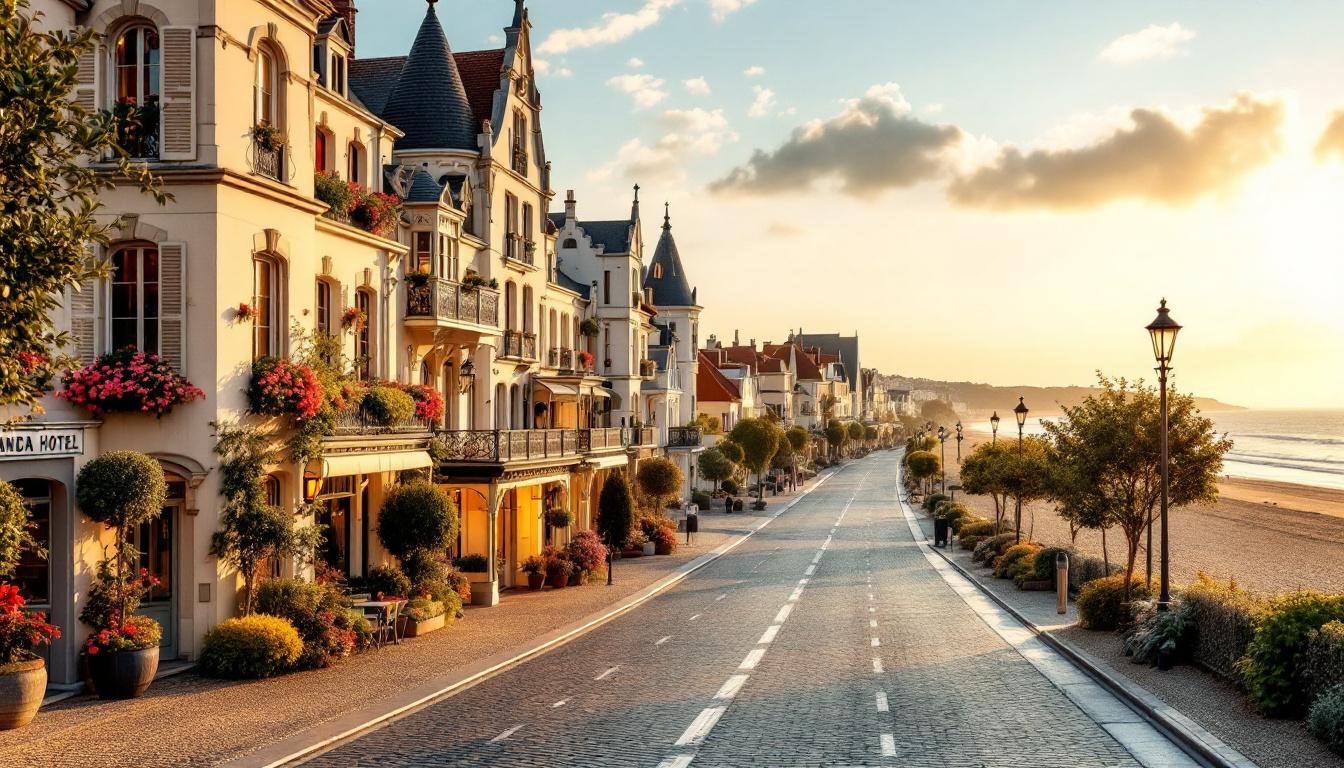Walking through the cobblestone streets of Cabourg, I overheard two elderly Norman women discussing the summer crowds. “Those tourists keep calling it ‘little Deauville,'” one whispered, “but honestly, it’s so much better.” That conversation changed how I see this Belle Époque jewel on Normandy’s coast.
Locals have their own names for this coastal gem. They call it “Balbec” after Marcel Proust’s literary creation, or simply refer to it as part of the “Côte Fleurie” – the Flowered Coast. But the nickname that made me smile? “Deauville without the pretension.”
After spending August in both towns, I understand why residents protect this comparison. Cabourg offers everything Deauville promises, but with authentic Norman charm instead of designer price tags.
The Belle Époque magic that locals treasure
Architecture that tells stories
Paul Leroux’s Greco-Roman theater design creates Cabourg’s unique starburst layout, with grand avenues radiating from the legendary Grand Hôtel. Unlike Deauville’s modern interruptions, every Belle Époque villa here remains intact, creating an authentic 1900s time capsule that locals fiercely preserve.
Proust’s reserved room at the Grand Hôtel
Between 1907-1914, Marcel Proust kept a reserved room overlooking the sea, transforming Cabourg into his fictional “Balbec.” The hotel staff still point out his favorite corner table, where he penned passages that would immortalize this Norman coast in literary history.
What makes it superior to famous Deauville
Four kilometers of uncrowded beach
While Deauville’s beach gets packed with designer umbrellas and €50 loungers, Cabourg’s 4-kilometer stretch offers space to breathe. The western sections remain virtually empty even in August, with locals sharing secret spots where Marcel Proust once took his morning walks.
Authentic prices versus tourist inflation
A seafood dinner at Le Poisson d’Argent costs €28 versus €65 in Deauville. Hotel rooms average €120 compared to Deauville’s €300+ summer rates. Locals joke that “you can actually afford to enjoy yourself here.”
The cultural experiences tourists miss
Villa du Temps Retrouvé and literary walks
This Proust-themed museum offers guided tours through the author’s creative process, with locals sharing family stories about the eccentric writer who preferred midnight strolls along their promenade. The experience feels intimate, not commercialized like typical literary tourist traps.
Norman specialties without tourist markup
Weekly markets sell authentic Camembert de Normandie and local Calvados at producer prices. Fishermen still sell morning catches directly from their boats, maintaining traditions that Deauville’s upscale restaurants have abandoned for imported ingredients.
Why locals call it their best-kept secret
August festivals that feel genuinely local
The Cabourg mon Amour music festival fills Belle Époque venues with regional performers, while the racecourse hosts traditional Norman trotting races. Unlike Deauville’s celebrity circus, these events celebrate authentic regional culture with locals significantly outnumbering tourists.
Weather that actually cooperates
August temperatures hover around 22°C with gentle sea breezes, perfect for photography and coastal walks. The microclimate stays milder than Deauville’s exposed beaches, with locals crediting the town’s theater-like geography for natural wind protection.
Standing on the Marcel Proust Promenade at sunset, watching families enjoying authentic Norman hospitality, I finally understood that local comparison. Cabourg isn’t trying to compete with Deauville’s glamour – it’s preserving something more valuable.
This Belle Époque treasure offers the sophisticated French coastal experience that Deauville once provided, before crowds and commerce changed its character. Sometimes the locals’ nickname says it all: it really is “better than Deauville.”
Planning your authentic Cabourg experience
When should I visit Cabourg for the best experience?
Late August through early September offers perfect weather with fewer crowds than peak July. The Belle Époque architecture photographs beautifully in golden hour light, and local restaurants aren’t overwhelmed with tourist reservations.
How does Cabourg compare cost-wise to Deauville?
Expect to pay 60% less than Deauville for similar quality accommodations and dining. A three-course Norman dinner averages €30 versus €50+ in Deauville, while beachfront hotels cost €120 compared to €300+ rates at comparable Deauville properties.
What makes the Proust connection authentic?
The Grand Hôtel preserves Proust’s actual room setup from 1907-1914, complete with period furniture and sea views that inspired his Balbec descriptions. The Villa du Temps Retrouvé museum offers manuscripts and personal items, creating genuine literary immersion rather than tourist recreation.
Are there local experiences unavailable in other Norman towns?
The four-kilometer beach promenade with intact Belle Époque villas remains unique in Normandy. Paul Leroux’s Greco-Roman theater town design creates architecture found nowhere else on the French coast, while traditional trotting races continue century-old Norman sporting traditions.
